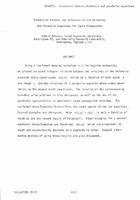| dc.contributor.author | DeSanto, John Anthony | |
| dc.date.accessioned | 2018-10-11T14:04:53Z | |
| dc.date.available | 2018-10-11T14:04:53Z | |
| dc.date.issued | 1975/10 | |
| dc.identifier | 343 | |
| dc.identifier.govdoc | CP-17/8 | |
| dc.identifier.uri | http://hdl.handle.net/20.500.12489/29 | |
| dc.description.abstract | Using a conformal mapping technique in a rectangular waveguide, we present an exact integral relation between the solutions of the Helmholtz equation whose sound speed c(x,y) varies as a function of both depth y and range x and the solutions of a parabolic equation whose sound speed varies in the mapped depth coordinate. The relation of the corresponding boundary value problems is also discussed, as well as the use of the . parabolic approximation in underwater sound propagation problems. The conformal transformation interrelates the sound speeds of the two equations. Several examples are discussed. When c(x,y) = c(y) is only a function of depth we get the recent result of Polyanskii. Other examples for a general conformal transformation are functions c(x»y) which are sinusoidal in depth and exponentially decrease to a constant in range. Several alternative methods of using these results are also discussed. | |
| dc.format | 17 p. : ill. ; digital, PDF file | |
| dc.language | English | |
| dc.publisher | NATO. SACLANTCEN | |
| dc.source | In: Ocean Acoustic Modelling (SACLANTCEN Conference Proceedings CP-17), Part 8, 1975, pp. 43-1 - 43-17. | |
| dc.subject | Acoustic propagation | |
| dc.subject | Sound velocity in sea water | |
| dc.subject | Helmholtz equation | |
| dc.subject | Parabolic equations | |
| dc.subject | Differential equations, Partial - Numerical solutions | |
| dc.title | Connection between the solution of the Helmholtz and parabolic equations for sound propagation | |
| dc.type | Papers and Articles | |
| dc.type | Conference Proceedings (CP) | |
